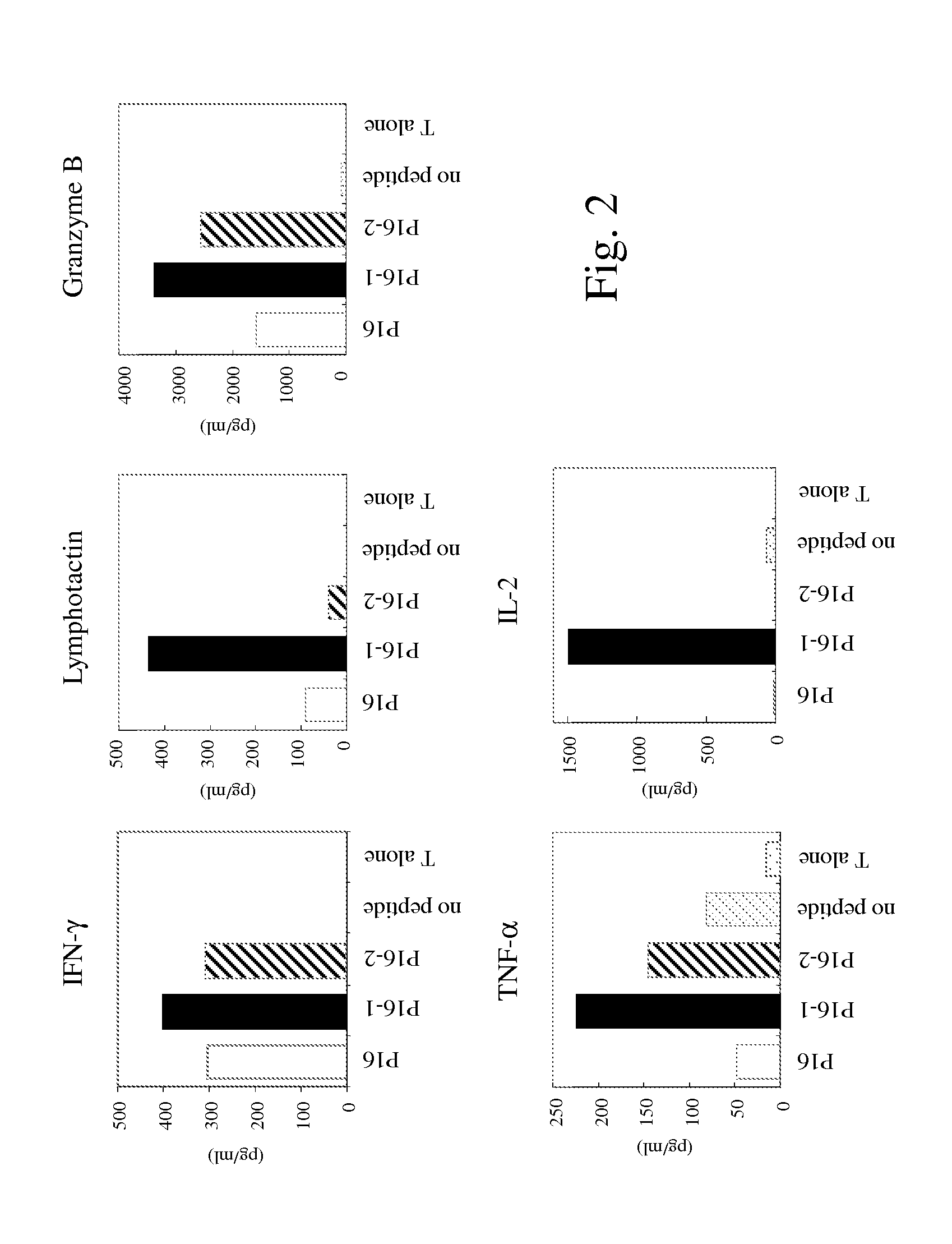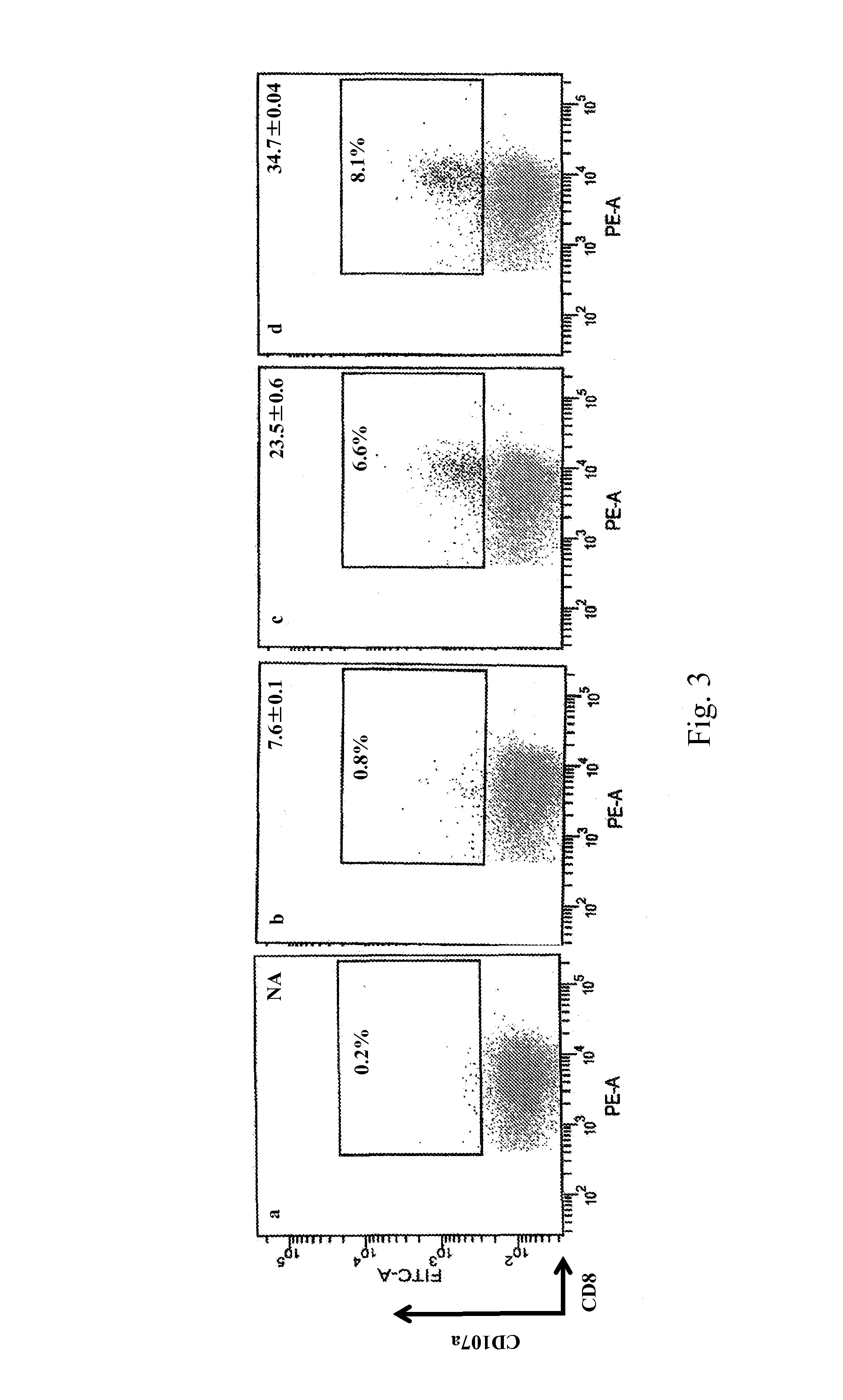Immunogenic peptides and methods of use
a technology of immunogenic peptides and peptides, applied in the field of cancer therapeutics, can solve the problems of early diagnosis, limited benefit of standard chemotherapy and hormone-based therapies for patients with metastatic prostate cancer, and metastases that may not be susceptible to surgical removal
- Summary
- Abstract
- Description
- Claims
- Application Information
AI Technical Summary
Benefits of technology
Problems solved by technology
Method used
Image
Examples
example 1
Materials and Methods
[0219]Cell Cultures: The human prostate carcinoma cell lines LNCaP (HLA-A2 positive and PAGE4 positive), 22Rv1 (HLA-A2 negative and PAGE4 positive), a human breast carcinoma cell line MCF-7 (HLA-A2 positive and PAGE4 negative) and a human pancreatic adenocarcinoma cell line AsPC-1 (HLA-A2 negative and PAGE4 negative) were purchased from American Type Culture Collection (Manassas, Va.). The cultures were free of mycoplasma and were maintained in complete medium [RPMI 1640 (Mediatech, Inc., Herndon, Va.) supplemented with 10% fetal bovine serum, 2 mM glutamine, 100 units / ml penicillin, and 100 μg / ml streptomycin (Mediatech, Inc.)]. PC3 / PAGE4 cells [PC3 cells, a prostate carcinoma cell line transfected with a full-length PAGE4 gene] (Iavarone et al., Mol Cancer Ther 2002; 1:329-35) were maintained in the complete medium with 0.5 μg / ml puromycin (Invitrogen, Carlsbad, Calif.). The T2 cells transfected with HLA-A2 gene (Hogan et al., J Exp Med 1988; 168:725-36) were ...
example 2
Binding Affinity of PAGE4 Peptides and Analogue Peptides to HLA-A2 Molecules
[0233]The primary amino acid sequence of human PAGE4 was analyzed for consensus motifs for novel HLA-A2 binding peptides. Two 10-mer peptides (P16-25 designated as P16 and P59-68 designated as P59) and one 9-mer peptide (P84-92 designated as P84) were identified and evaluated (Table 1). Analysis of the primary and secondary HLA-A2 binding anchor amino acid residues at positions 1, 2, 8 and 10 of the native peptides revealed that modification of amino acids at these positions could potentially enhance the binding ability of the peptide to the HLA-A2 molecule. For this reason, five different analogues of native peptides were synthesized and were investigated for their binding ability to HLA-A2-positive T2 cells along with the native P16, P59 and P84 peptides. A MUC-1 peptide and a CEA HLA-A3 binding peptide (CAP-7) were used as a positive and negative control, respectively (Tsang et al., J Natl Cancer Inst 199...
example 3
Immunogenicity of the PAGE4 Native and Agonist Peptides
[0237]Studies were conducted to determine whether T-cell lines could be generated from PBMC from prostate cancer patients . . . . Autologous DCs were used as APC. Five PAGE4-specific T-cell lines were generated from a prostate cancer patient (A) using P16, P16-1, P16-2, P84 and P84-1 peptides (see Example 1). The T-cell lines were designated T-A-P16, T-A-P16-1, T-A-P16-2, T-A-P84 and T-A-P84-1. The specificity of the PAGE4-specific T cells was analyzed for their ability to release IFN-γ after stimulation with autologous B cells pulsed with the corresponding peptides. As shown in Table 2, high levels of IFN-γ production were observed when the T-cell lines were stimulated with the specific peptide.
[0238]
TABLE 2Production of IFN-γ by T-cell lines generated from a prostatecancer patient stimulated with P16, P84 and their agonist peptidesProduction of IFN-γ (pg / ml)T-cell lineCorresponding peptideNoneT-A-P16302.0T-A-P16-1611.6T-A-P16-...
PUM
| Property | Measurement | Unit |
|---|---|---|
| concentrations | aaaaa | aaaaa |
| concentration | aaaaa | aaaaa |
| temperature | aaaaa | aaaaa |
Abstract
Description
Claims
Application Information
 Login to View More
Login to View More - R&D
- Intellectual Property
- Life Sciences
- Materials
- Tech Scout
- Unparalleled Data Quality
- Higher Quality Content
- 60% Fewer Hallucinations
Browse by: Latest US Patents, China's latest patents, Technical Efficacy Thesaurus, Application Domain, Technology Topic, Popular Technical Reports.
© 2025 PatSnap. All rights reserved.Legal|Privacy policy|Modern Slavery Act Transparency Statement|Sitemap|About US| Contact US: help@patsnap.com



